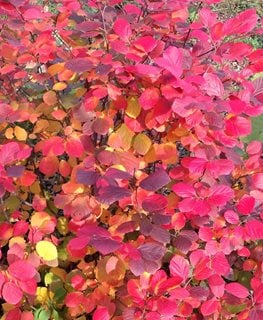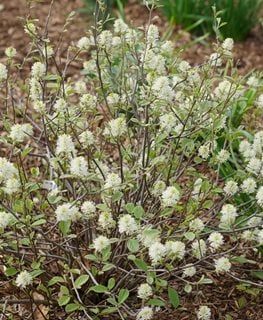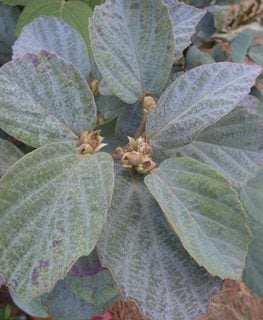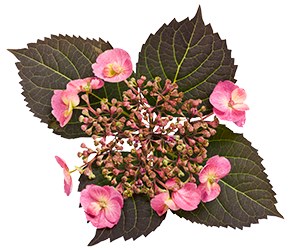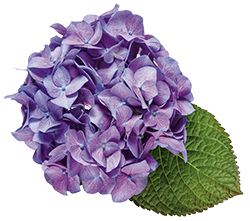Grow Fothergilla for Fabulous Flowers and Foliage
Get tips for planting, caring for, and using this easy-care native shrub.Fothergilla is one of those rare garden shrubs grown as much for its spectacular fall foliage as it is for its showy flowers in spring. In autumn, its leaves turn every color of the fall rainbow—a breathtaking blend of orange, red, crimson, and yellow, with the display often lingering well into November.
In early spring, after a brief winter nap, its branches are covered with creamy white bottlebrush-shaped blossoms, followed soon after by handsome blue-green leaves. Even in winter, when the foliage is absent, fothergilla continues to captivate in the garden with its zigzagging branches.
In addition to these many ornamental attributes, fothergilla is happy growing in sun or shade and requires minimal pruning to maintain its beautiful form.
“They do not have a bad season,” says horticulturist Michael Dirr, extolling the virtues of fothergilla in his book Dirr’s Trees and Shrubs. "They have assumed their rightful place in American gardens as magnificent shrubs that offer superb flowers and foliage, in both summer and fall."
On this page: Basics | Types | Planting | Care | Varieties | Landscaping Ideas
- BASICS
- TYPES OF FOTHERGILLA
- HOW TO PLANT FOTHERGILLA
- FOTHERGILLA CARE
- FOTHERGILLA VARIETIES
- LANDSCAPING IDEAS
BASICS
Zones:
Typically 5 to 9, with some varieties hardy down to zone 4.
Common name:
Witch alder (so called because of its similarity to witch hazel, which belongs to the same plant family)
Plant type:
Deciduous shrub
Native area:
Eastern and southeastern U.S.
Exposure:
Full sun to part shade
Mature size:
Varies; from 2 to 3 feet tall and wide to up to 6 to 10 feet
Growth rate:
Slow
Bloom time:
Early to mid-spring, with the flowers lasting 2 to 3 weeks
Special attributes:
- Attracts bees and butterflies
- Deer resistant
TYPES OF FOTHERGILLA
- Fothergilla gardenii (dwarf fothergilla) grows 2 to 3 feet high and wide, with a compact, rounded form.
- Fothergilla major (large fothergilla) is taller and more upright than its smaller cousin and typically has larger flower clusters and leaves. Can grow to a height of 6 to 10 feet.
- Fothergilla x intermedia are hybrid selections of the two species and may have traits such as bluer leaves, more prolific blooming, and better fall color.
HOW TO PLANT FOTHERGILLA
When to plant:
As with most shrubs, plant during the cooler months of spring or fall to avoid transplant shock from extreme summer heat.
Where to plant:
Choose a sunny to partly sunny site with moist, well-draining soil. Best flowering and fall color typically occur when plants are exposed to full sun. However, in hotter climates, they will welcome some afternoon shade.
Soil:
Prefers slightly acidic soil enriched with plenty of organic matter.
How to plant:
Place in a hole dug to the same depth and twice the width of the rootball, making sure the top of the rootball is even with or slightly above the soil surface. After backfilling, water deeply to thoroughly saturate the roots and the surrounding soil.
Spacing:
If planting in groups, space plants at a distance equal to or greater than their width at maturity, depending on their purpose.
FOTHERGILLA CARE
Watering:
Water newly planted fothergilla regularly during its first growing season to maintain evenly moist soil. Once the root system becomes established, supplemental watering is only needed during periods of drought.
Mulch:
Fothergillas have a shallow root system and benefit from the application of a thick layer of mulch or other organic matter to help keep the soil moist and protect the roots from temperature extremes.
Fertilizing:
If growing plants in alkaline soil, fertilize in spring with an organic plant food specially formulated for acid-loving plants or blend some aluminum sulfate into the soil to lower the pH level. (Learn how to test the pH of your soil.)
Pruning:
One of the best reasons to grow Fothergilla is the beauty of its informal branching habit, so pruning should be kept to a minimum to avoid spoiling the shrub’s natural shape.
Cut out dead branches in winter, but wait to do any further pruning until late spring—after the flowers are gone— because Fothergilla blooms on the previous year’s growth. Use bypass pruners to cut smaller branches back to an outward-facing bud, and use loppers for larger branches.
Controlling spread:
Some fothergillas have a tendency to spread by root suckering, but they are easy to keep in check by clipping off the unwanted suckers at the base.
Pests and diseases:
Free of most pests and diseases. However, plants can suffer from chlorosis (yellowing of the leaves) when grown in alkaline soil.
FOTHERGILLA VARIETIES
LANDSCAPING IDEAS
- Plant in a butterfly or cottage garden as an attractive specimen or accent plant. The fragrant, nectar-rich flowers will entice pollinators in the spring.
- In smaller gardens, use dwarf fothergillas in shrub borders or as fillers to provide multiseason interest.
- Mix in landscape beds with other spring-flowering shrubs that prefer acidic soil, such as rhododendrons or azaleas, and viburnums. Fothergilla also pairs nicely with oakleaf hydrangea, another native shrub that thrives in similar conditions and has colorful fall foliage.
- Allow to naturalize in woodland gardens or other areas having dappled shade.
- Use as an eco-friendly alternative to the more invasive burning bush (Euonymus alatus) for striking fall foliage color.
RELATED:
Best Flowering Shrubs for Season-Long Color
The Best Deer Resistant Plants for Your Garden
21 Low-Maintenance Plants






